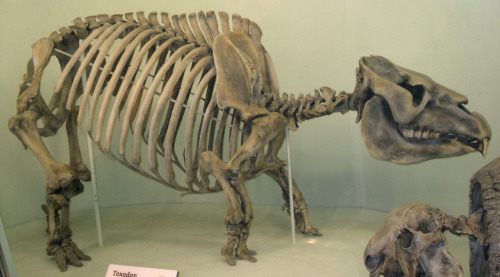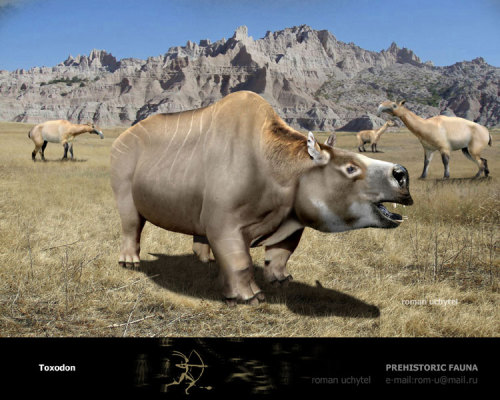Toxodon Mounted specimen on display at Harvard Museum of Natural History Reconstruction by Roman&nbs
Toxodon Mounted specimen on display at Harvard Museum of Natural History Reconstruction by Roman Uchytel When: Pleistocene (~2.6 million to 16,000 years ago) Where: South America What: Toxodon is another one of the large herbivorous animals that roamed over South America. Charles Darwin purchased the skull of the first Toxodon known to the Old World during his journey on the Beagle. This skull was sent back to England were Sir Richard Own described it and named the animal Toxodon - ‘bow teeth' based on the curving nature of its gigantic molars. Soon complete skeletons of this amazing animal were known. The first interpratations reconstructed Toxodon as a semi-aquatic animal, much like the modern hippo, but later studies of the limbs and teeth of speciemens show this was incorrect. Toxodon was more the analogue of today’s rhinos than a hippo, a fully terrestrial animal with teeth well adapted for grinding tough plants in somewhat arid environments. Some Toxodon specimens have been found associated with arrowheads, showing that the first people to emigrate into South America had contact with these animals, and appear to have hunted them. Where does Toxodon fit into the tree of life? Like its contemporary Macrauchenia (which you can see in the background of the reconstruction), its relationship to living mammals is uncertain. It falls into the larger clade of Notoungulata, literally Southern Ungulates, but the placment of this group within placental mammals is highly uncertain. They maybe have a close relationship with animals in the group Afrotheria but research in mammalian systematics is only beginning to be able to evaluate that, and other hypotheses. So what is Toxodon? We just don’t know. -- source link
Tumblr Blog : dailyfossil.tumblr.com
#cenozoic#pleistocene#south america#mammal#eutheria#placental#geology#biology#science#fossil#paleontology

